GNs Transition: Challenges and Strategies in Healthcare Setting
VerifiedAdded on 2020/05/08
|8
|2226
|64
Essay
AI Summary
This essay examines the challenges faced by graduate nurses (GNs) during their transition to the healthcare workforce, focusing on the issue of assimilation and the need for support within healthcare institutions. The author discusses personal experiences and observations, highlighting difficulties in communication, acceptance by the team, and the impact of temporary employment contracts. The essay explores various strategies to address these challenges, including mentorship programs, residency programs, shared governance, and interprofessional decision-making. The author references several studies to support these strategies, emphasizing the importance of structured support, autonomy, and critical thinking skills for new GNs. The conclusion emphasizes the need for healthcare institutions to understand the challenges faced by new GNs and to implement strategies that facilitate their successful integration into the workforce, ultimately ensuring a sufficient supply of skilled nurses to meet patient needs.
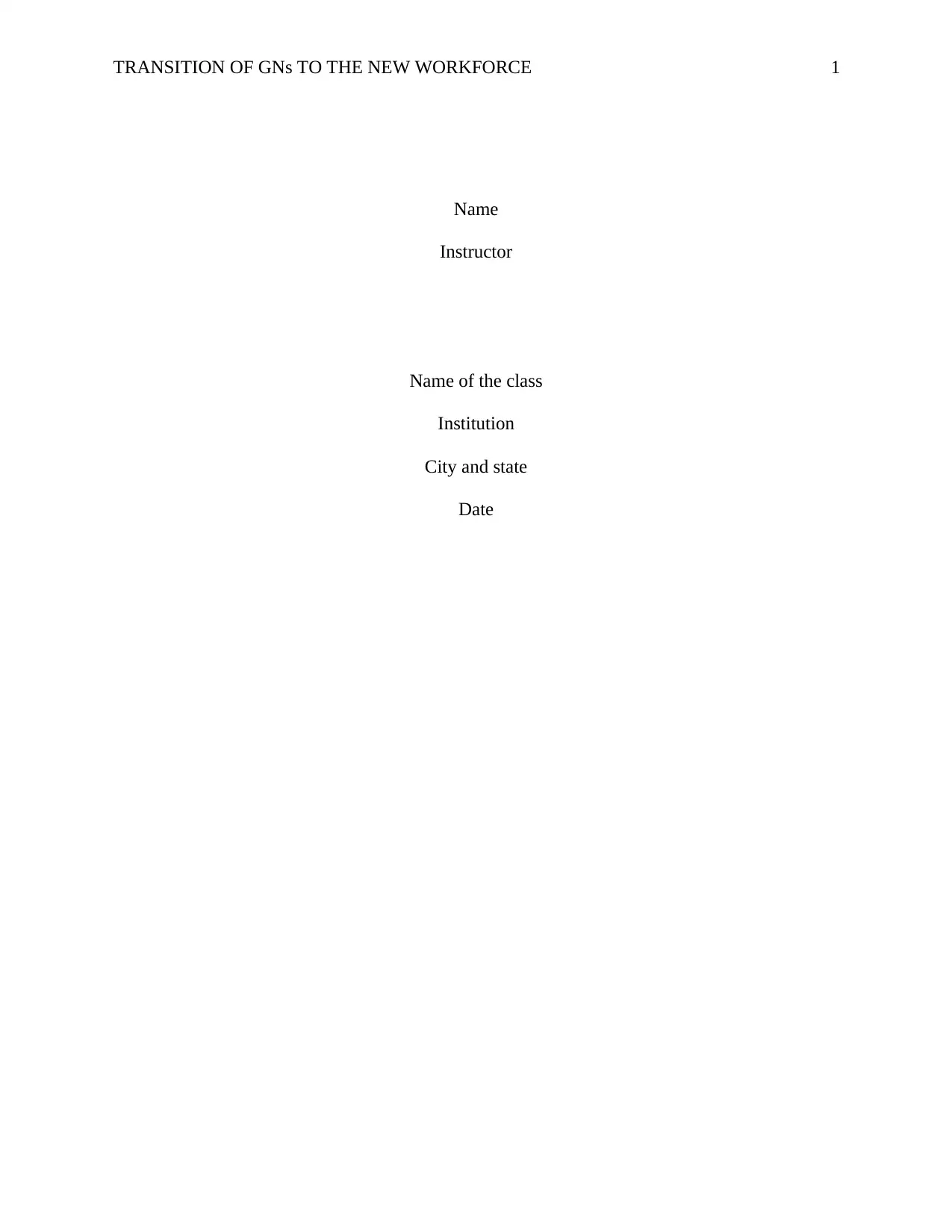
TRANSITION OF GNs TO THE NEW WORKFORCE 1
Name
Instructor
Name of the class
Institution
City and state
Date
Name
Instructor
Name of the class
Institution
City and state
Date
Paraphrase This Document
Need a fresh take? Get an instant paraphrase of this document with our AI Paraphraser
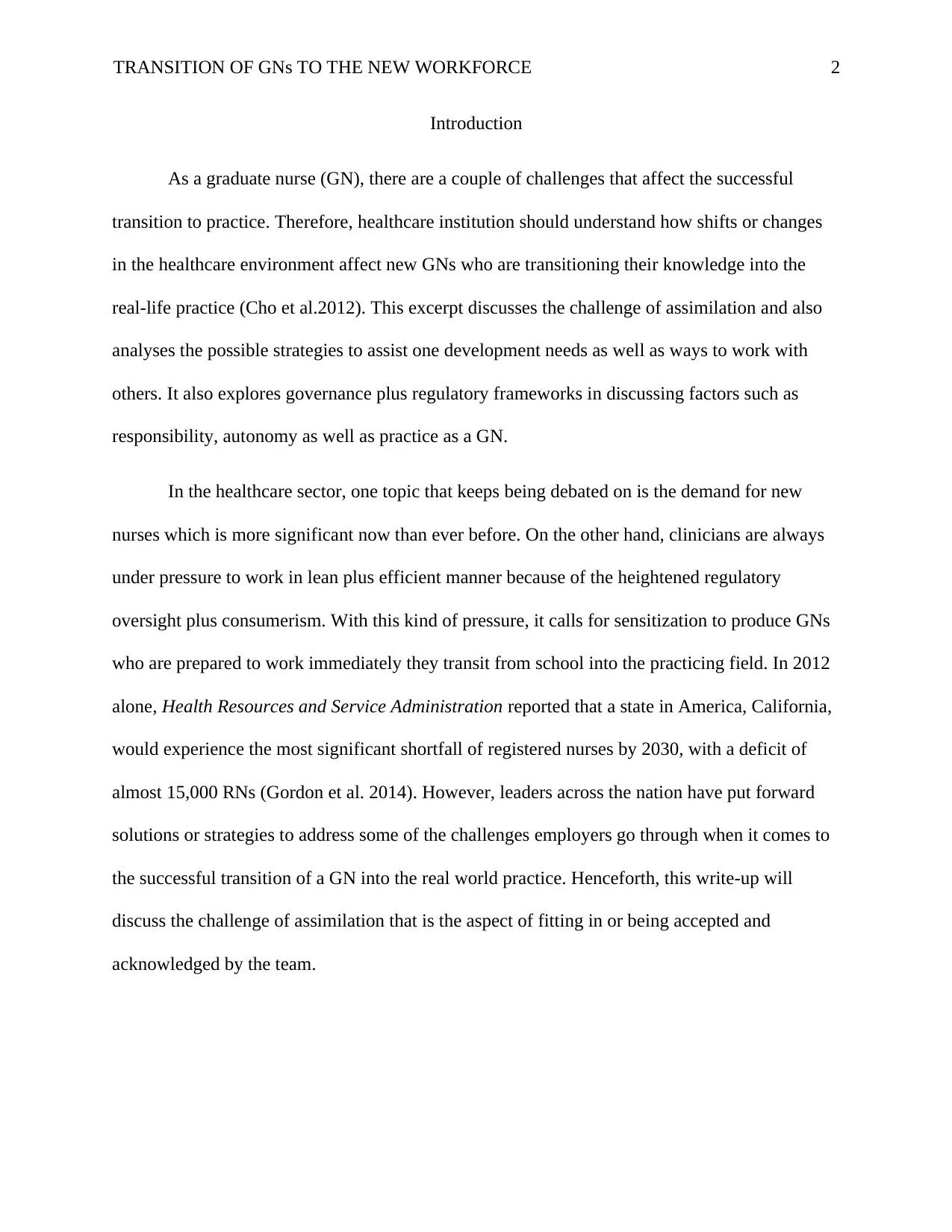
TRANSITION OF GNs TO THE NEW WORKFORCE 2
Introduction
As a graduate nurse (GN), there are a couple of challenges that affect the successful
transition to practice. Therefore, healthcare institution should understand how shifts or changes
in the healthcare environment affect new GNs who are transitioning their knowledge into the
real-life practice (Cho et al.2012). This excerpt discusses the challenge of assimilation and also
analyses the possible strategies to assist one development needs as well as ways to work with
others. It also explores governance plus regulatory frameworks in discussing factors such as
responsibility, autonomy as well as practice as a GN.
In the healthcare sector, one topic that keeps being debated on is the demand for new
nurses which is more significant now than ever before. On the other hand, clinicians are always
under pressure to work in lean plus efficient manner because of the heightened regulatory
oversight plus consumerism. With this kind of pressure, it calls for sensitization to produce GNs
who are prepared to work immediately they transit from school into the practicing field. In 2012
alone, Health Resources and Service Administration reported that a state in America, California,
would experience the most significant shortfall of registered nurses by 2030, with a deficit of
almost 15,000 RNs (Gordon et al. 2014). However, leaders across the nation have put forward
solutions or strategies to address some of the challenges employers go through when it comes to
the successful transition of a GN into the real world practice. Henceforth, this write-up will
discuss the challenge of assimilation that is the aspect of fitting in or being accepted and
acknowledged by the team.
Introduction
As a graduate nurse (GN), there are a couple of challenges that affect the successful
transition to practice. Therefore, healthcare institution should understand how shifts or changes
in the healthcare environment affect new GNs who are transitioning their knowledge into the
real-life practice (Cho et al.2012). This excerpt discusses the challenge of assimilation and also
analyses the possible strategies to assist one development needs as well as ways to work with
others. It also explores governance plus regulatory frameworks in discussing factors such as
responsibility, autonomy as well as practice as a GN.
In the healthcare sector, one topic that keeps being debated on is the demand for new
nurses which is more significant now than ever before. On the other hand, clinicians are always
under pressure to work in lean plus efficient manner because of the heightened regulatory
oversight plus consumerism. With this kind of pressure, it calls for sensitization to produce GNs
who are prepared to work immediately they transit from school into the practicing field. In 2012
alone, Health Resources and Service Administration reported that a state in America, California,
would experience the most significant shortfall of registered nurses by 2030, with a deficit of
almost 15,000 RNs (Gordon et al. 2014). However, leaders across the nation have put forward
solutions or strategies to address some of the challenges employers go through when it comes to
the successful transition of a GN into the real world practice. Henceforth, this write-up will
discuss the challenge of assimilation that is the aspect of fitting in or being accepted and
acknowledged by the team.
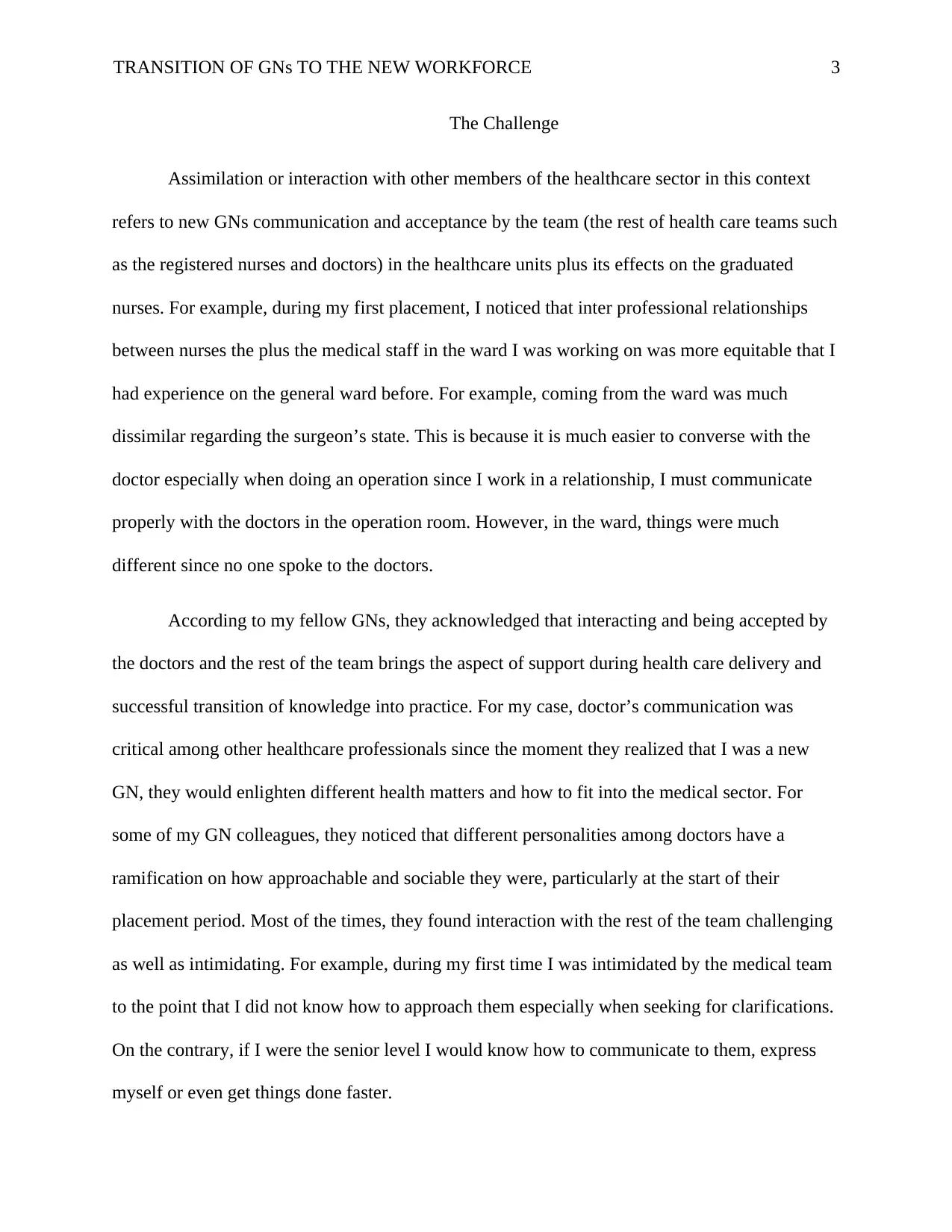
TRANSITION OF GNs TO THE NEW WORKFORCE 3
The Challenge
Assimilation or interaction with other members of the healthcare sector in this context
refers to new GNs communication and acceptance by the team (the rest of health care teams such
as the registered nurses and doctors) in the healthcare units plus its effects on the graduated
nurses. For example, during my first placement, I noticed that inter professional relationships
between nurses the plus the medical staff in the ward I was working on was more equitable that I
had experience on the general ward before. For example, coming from the ward was much
dissimilar regarding the surgeon’s state. This is because it is much easier to converse with the
doctor especially when doing an operation since I work in a relationship, I must communicate
properly with the doctors in the operation room. However, in the ward, things were much
different since no one spoke to the doctors.
According to my fellow GNs, they acknowledged that interacting and being accepted by
the doctors and the rest of the team brings the aspect of support during health care delivery and
successful transition of knowledge into practice. For my case, doctor’s communication was
critical among other healthcare professionals since the moment they realized that I was a new
GN, they would enlighten different health matters and how to fit into the medical sector. For
some of my GN colleagues, they noticed that different personalities among doctors have a
ramification on how approachable and sociable they were, particularly at the start of their
placement period. Most of the times, they found interaction with the rest of the team challenging
as well as intimidating. For example, during my first time I was intimidated by the medical team
to the point that I did not know how to approach them especially when seeking for clarifications.
On the contrary, if I were the senior level I would know how to communicate to them, express
myself or even get things done faster.
The Challenge
Assimilation or interaction with other members of the healthcare sector in this context
refers to new GNs communication and acceptance by the team (the rest of health care teams such
as the registered nurses and doctors) in the healthcare units plus its effects on the graduated
nurses. For example, during my first placement, I noticed that inter professional relationships
between nurses the plus the medical staff in the ward I was working on was more equitable that I
had experience on the general ward before. For example, coming from the ward was much
dissimilar regarding the surgeon’s state. This is because it is much easier to converse with the
doctor especially when doing an operation since I work in a relationship, I must communicate
properly with the doctors in the operation room. However, in the ward, things were much
different since no one spoke to the doctors.
According to my fellow GNs, they acknowledged that interacting and being accepted by
the doctors and the rest of the team brings the aspect of support during health care delivery and
successful transition of knowledge into practice. For my case, doctor’s communication was
critical among other healthcare professionals since the moment they realized that I was a new
GN, they would enlighten different health matters and how to fit into the medical sector. For
some of my GN colleagues, they noticed that different personalities among doctors have a
ramification on how approachable and sociable they were, particularly at the start of their
placement period. Most of the times, they found interaction with the rest of the team challenging
as well as intimidating. For example, during my first time I was intimidated by the medical team
to the point that I did not know how to approach them especially when seeking for clarifications.
On the contrary, if I were the senior level I would know how to communicate to them, express
myself or even get things done faster.
⊘ This is a preview!⊘
Do you want full access?
Subscribe today to unlock all pages.

Trusted by 1+ million students worldwide
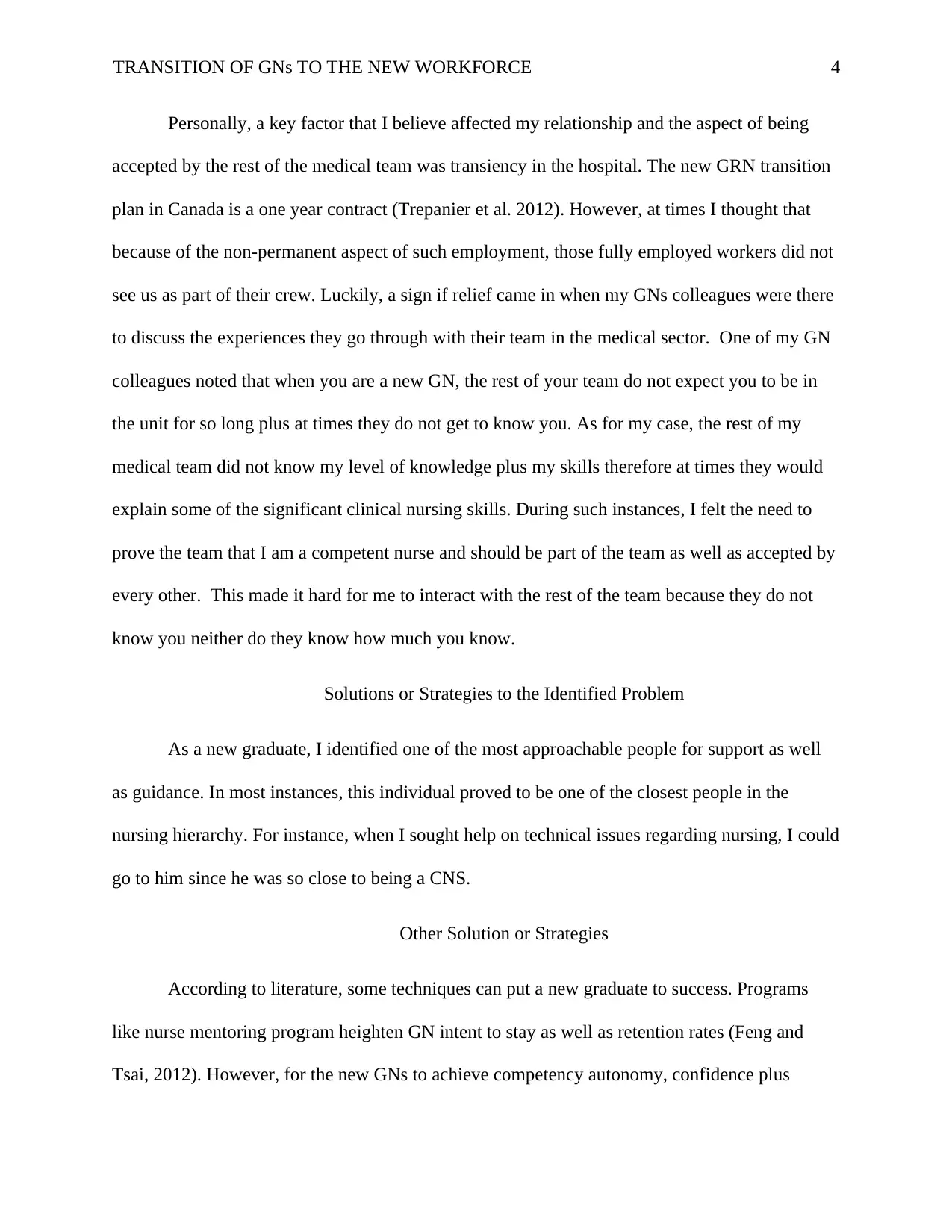
TRANSITION OF GNs TO THE NEW WORKFORCE 4
Personally, a key factor that I believe affected my relationship and the aspect of being
accepted by the rest of the medical team was transiency in the hospital. The new GRN transition
plan in Canada is a one year contract (Trepanier et al. 2012). However, at times I thought that
because of the non-permanent aspect of such employment, those fully employed workers did not
see us as part of their crew. Luckily, a sign if relief came in when my GNs colleagues were there
to discuss the experiences they go through with their team in the medical sector. One of my GN
colleagues noted that when you are a new GN, the rest of your team do not expect you to be in
the unit for so long plus at times they do not get to know you. As for my case, the rest of my
medical team did not know my level of knowledge plus my skills therefore at times they would
explain some of the significant clinical nursing skills. During such instances, I felt the need to
prove the team that I am a competent nurse and should be part of the team as well as accepted by
every other. This made it hard for me to interact with the rest of the team because they do not
know you neither do they know how much you know.
Solutions or Strategies to the Identified Problem
As a new graduate, I identified one of the most approachable people for support as well
as guidance. In most instances, this individual proved to be one of the closest people in the
nursing hierarchy. For instance, when I sought help on technical issues regarding nursing, I could
go to him since he was so close to being a CNS.
Other Solution or Strategies
According to literature, some techniques can put a new graduate to success. Programs
like nurse mentoring program heighten GN intent to stay as well as retention rates (Feng and
Tsai, 2012). However, for the new GNs to achieve competency autonomy, confidence plus
Personally, a key factor that I believe affected my relationship and the aspect of being
accepted by the rest of the medical team was transiency in the hospital. The new GRN transition
plan in Canada is a one year contract (Trepanier et al. 2012). However, at times I thought that
because of the non-permanent aspect of such employment, those fully employed workers did not
see us as part of their crew. Luckily, a sign if relief came in when my GNs colleagues were there
to discuss the experiences they go through with their team in the medical sector. One of my GN
colleagues noted that when you are a new GN, the rest of your team do not expect you to be in
the unit for so long plus at times they do not get to know you. As for my case, the rest of my
medical team did not know my level of knowledge plus my skills therefore at times they would
explain some of the significant clinical nursing skills. During such instances, I felt the need to
prove the team that I am a competent nurse and should be part of the team as well as accepted by
every other. This made it hard for me to interact with the rest of the team because they do not
know you neither do they know how much you know.
Solutions or Strategies to the Identified Problem
As a new graduate, I identified one of the most approachable people for support as well
as guidance. In most instances, this individual proved to be one of the closest people in the
nursing hierarchy. For instance, when I sought help on technical issues regarding nursing, I could
go to him since he was so close to being a CNS.
Other Solution or Strategies
According to literature, some techniques can put a new graduate to success. Programs
like nurse mentoring program heighten GN intent to stay as well as retention rates (Feng and
Tsai, 2012). However, for the new GNs to achieve competency autonomy, confidence plus
Paraphrase This Document
Need a fresh take? Get an instant paraphrase of this document with our AI Paraphraser
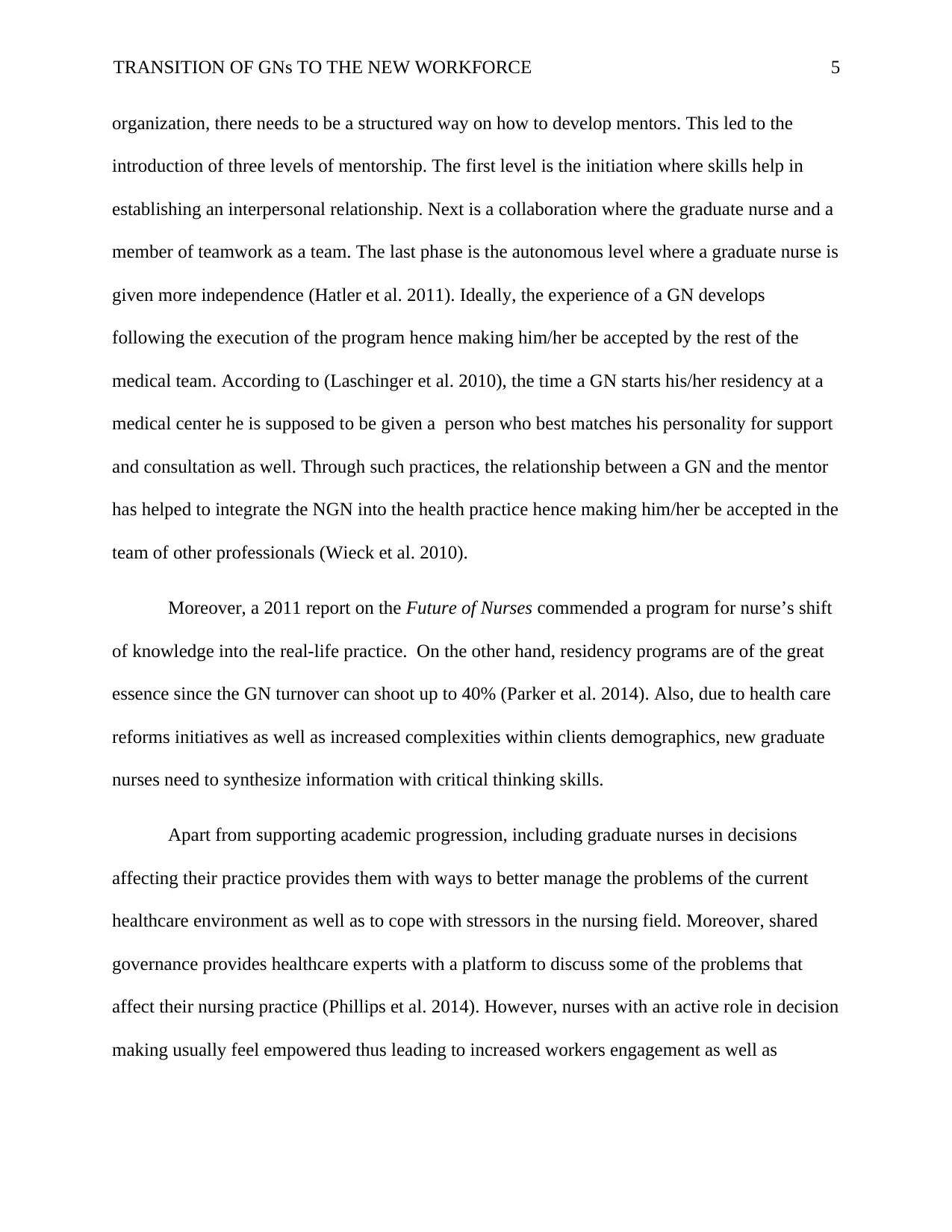
TRANSITION OF GNs TO THE NEW WORKFORCE 5
organization, there needs to be a structured way on how to develop mentors. This led to the
introduction of three levels of mentorship. The first level is the initiation where skills help in
establishing an interpersonal relationship. Next is a collaboration where the graduate nurse and a
member of teamwork as a team. The last phase is the autonomous level where a graduate nurse is
given more independence (Hatler et al. 2011). Ideally, the experience of a GN develops
following the execution of the program hence making him/her be accepted by the rest of the
medical team. According to (Laschinger et al. 2010), the time a GN starts his/her residency at a
medical center he is supposed to be given a person who best matches his personality for support
and consultation as well. Through such practices, the relationship between a GN and the mentor
has helped to integrate the NGN into the health practice hence making him/her be accepted in the
team of other professionals (Wieck et al. 2010).
Moreover, a 2011 report on the Future of Nurses commended a program for nurse’s shift
of knowledge into the real-life practice. On the other hand, residency programs are of the great
essence since the GN turnover can shoot up to 40% (Parker et al. 2014). Also, due to health care
reforms initiatives as well as increased complexities within clients demographics, new graduate
nurses need to synthesize information with critical thinking skills.
Apart from supporting academic progression, including graduate nurses in decisions
affecting their practice provides them with ways to better manage the problems of the current
healthcare environment as well as to cope with stressors in the nursing field. Moreover, shared
governance provides healthcare experts with a platform to discuss some of the problems that
affect their nursing practice (Phillips et al. 2014). However, nurses with an active role in decision
making usually feel empowered thus leading to increased workers engagement as well as
organization, there needs to be a structured way on how to develop mentors. This led to the
introduction of three levels of mentorship. The first level is the initiation where skills help in
establishing an interpersonal relationship. Next is a collaboration where the graduate nurse and a
member of teamwork as a team. The last phase is the autonomous level where a graduate nurse is
given more independence (Hatler et al. 2011). Ideally, the experience of a GN develops
following the execution of the program hence making him/her be accepted by the rest of the
medical team. According to (Laschinger et al. 2010), the time a GN starts his/her residency at a
medical center he is supposed to be given a person who best matches his personality for support
and consultation as well. Through such practices, the relationship between a GN and the mentor
has helped to integrate the NGN into the health practice hence making him/her be accepted in the
team of other professionals (Wieck et al. 2010).
Moreover, a 2011 report on the Future of Nurses commended a program for nurse’s shift
of knowledge into the real-life practice. On the other hand, residency programs are of the great
essence since the GN turnover can shoot up to 40% (Parker et al. 2014). Also, due to health care
reforms initiatives as well as increased complexities within clients demographics, new graduate
nurses need to synthesize information with critical thinking skills.
Apart from supporting academic progression, including graduate nurses in decisions
affecting their practice provides them with ways to better manage the problems of the current
healthcare environment as well as to cope with stressors in the nursing field. Moreover, shared
governance provides healthcare experts with a platform to discuss some of the problems that
affect their nursing practice (Phillips et al. 2014). However, nurses with an active role in decision
making usually feel empowered thus leading to increased workers engagement as well as
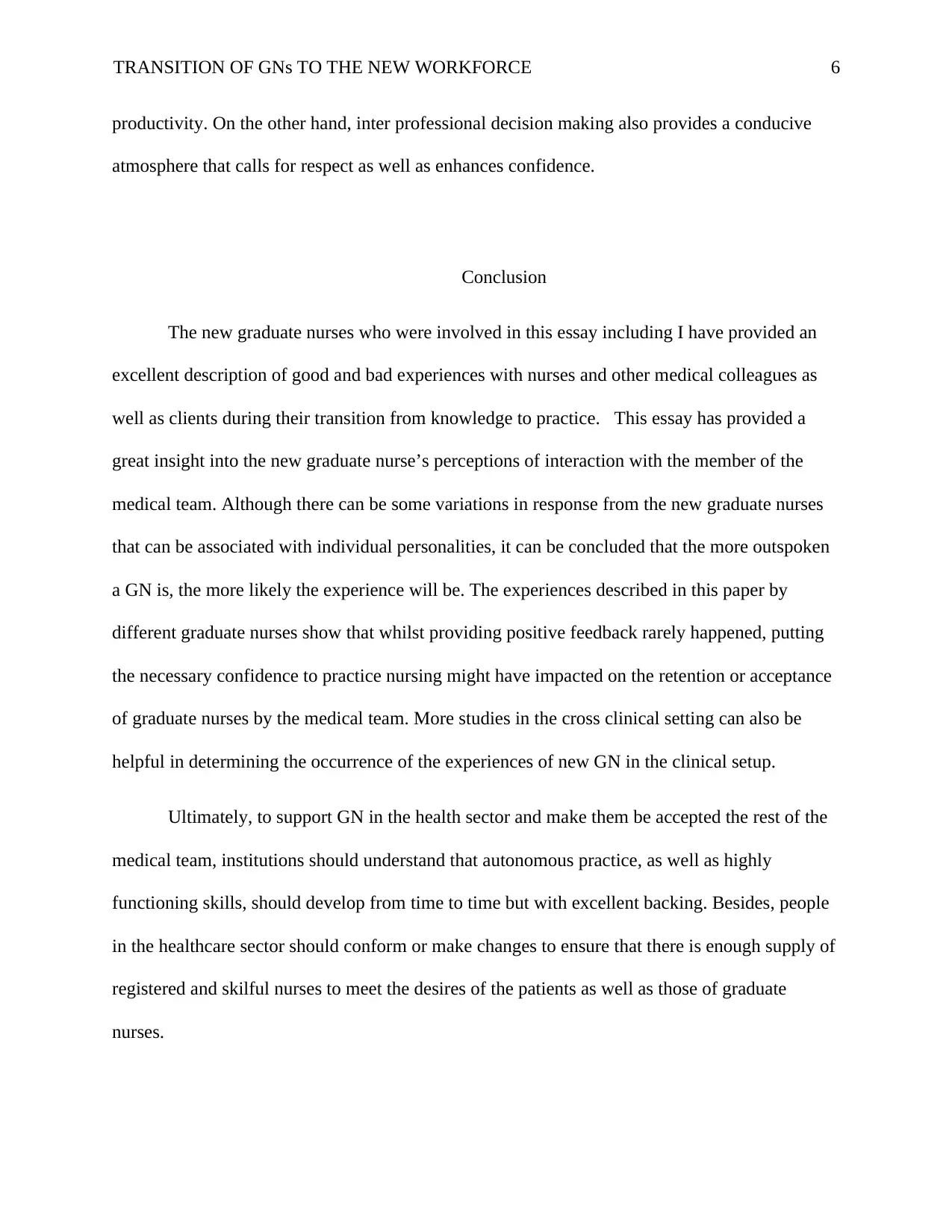
TRANSITION OF GNs TO THE NEW WORKFORCE 6
productivity. On the other hand, inter professional decision making also provides a conducive
atmosphere that calls for respect as well as enhances confidence.
Conclusion
The new graduate nurses who were involved in this essay including I have provided an
excellent description of good and bad experiences with nurses and other medical colleagues as
well as clients during their transition from knowledge to practice. This essay has provided a
great insight into the new graduate nurse’s perceptions of interaction with the member of the
medical team. Although there can be some variations in response from the new graduate nurses
that can be associated with individual personalities, it can be concluded that the more outspoken
a GN is, the more likely the experience will be. The experiences described in this paper by
different graduate nurses show that whilst providing positive feedback rarely happened, putting
the necessary confidence to practice nursing might have impacted on the retention or acceptance
of graduate nurses by the medical team. More studies in the cross clinical setting can also be
helpful in determining the occurrence of the experiences of new GN in the clinical setup.
Ultimately, to support GN in the health sector and make them be accepted the rest of the
medical team, institutions should understand that autonomous practice, as well as highly
functioning skills, should develop from time to time but with excellent backing. Besides, people
in the healthcare sector should conform or make changes to ensure that there is enough supply of
registered and skilful nurses to meet the desires of the patients as well as those of graduate
nurses.
productivity. On the other hand, inter professional decision making also provides a conducive
atmosphere that calls for respect as well as enhances confidence.
Conclusion
The new graduate nurses who were involved in this essay including I have provided an
excellent description of good and bad experiences with nurses and other medical colleagues as
well as clients during their transition from knowledge to practice. This essay has provided a
great insight into the new graduate nurse’s perceptions of interaction with the member of the
medical team. Although there can be some variations in response from the new graduate nurses
that can be associated with individual personalities, it can be concluded that the more outspoken
a GN is, the more likely the experience will be. The experiences described in this paper by
different graduate nurses show that whilst providing positive feedback rarely happened, putting
the necessary confidence to practice nursing might have impacted on the retention or acceptance
of graduate nurses by the medical team. More studies in the cross clinical setting can also be
helpful in determining the occurrence of the experiences of new GN in the clinical setup.
Ultimately, to support GN in the health sector and make them be accepted the rest of the
medical team, institutions should understand that autonomous practice, as well as highly
functioning skills, should develop from time to time but with excellent backing. Besides, people
in the healthcare sector should conform or make changes to ensure that there is enough supply of
registered and skilful nurses to meet the desires of the patients as well as those of graduate
nurses.
⊘ This is a preview!⊘
Do you want full access?
Subscribe today to unlock all pages.

Trusted by 1+ million students worldwide
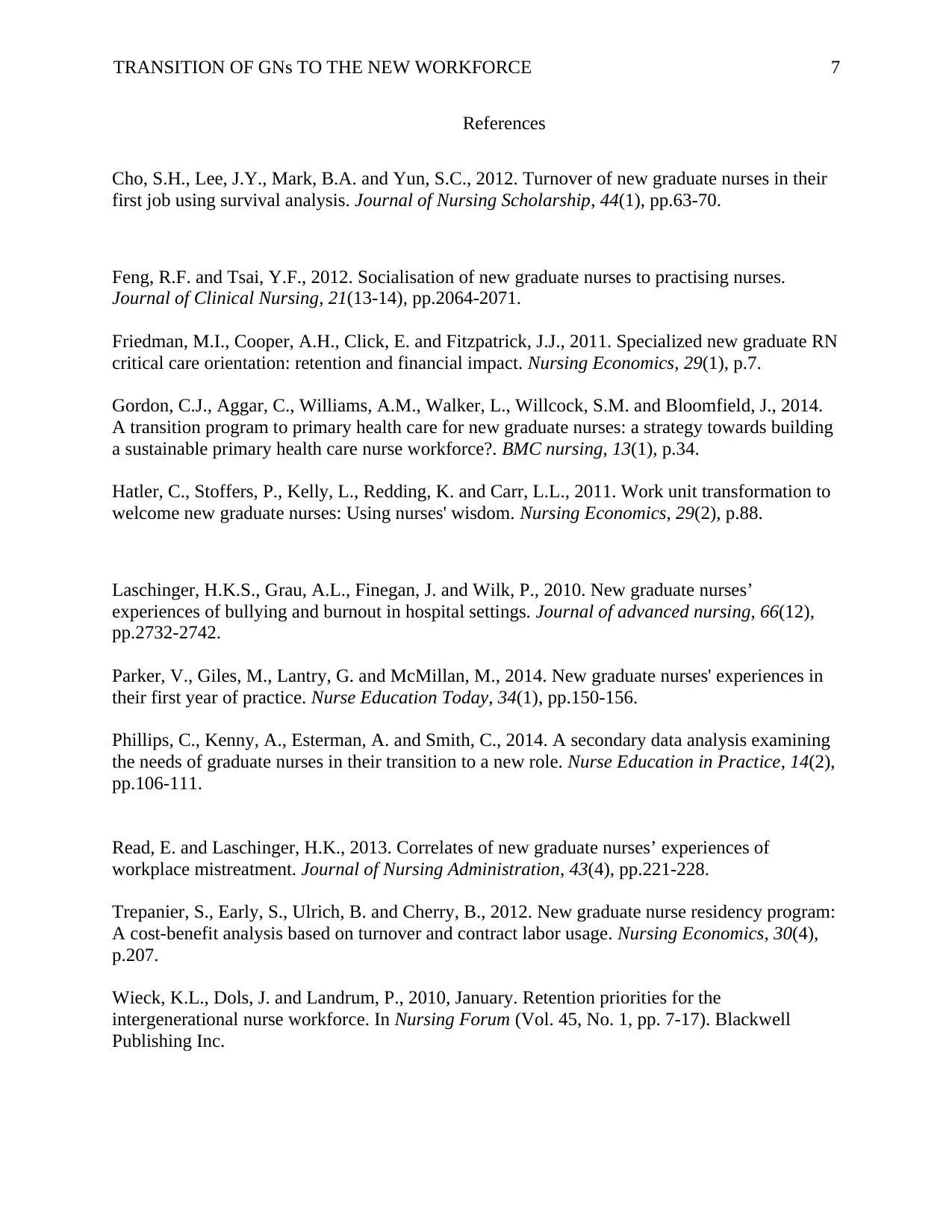
TRANSITION OF GNs TO THE NEW WORKFORCE 7
References
Cho, S.H., Lee, J.Y., Mark, B.A. and Yun, S.C., 2012. Turnover of new graduate nurses in their
first job using survival analysis. Journal of Nursing Scholarship, 44(1), pp.63-70.
Feng, R.F. and Tsai, Y.F., 2012. Socialisation of new graduate nurses to practising nurses.
Journal of Clinical Nursing, 21(13-14), pp.2064-2071.
Friedman, M.I., Cooper, A.H., Click, E. and Fitzpatrick, J.J., 2011. Specialized new graduate RN
critical care orientation: retention and financial impact. Nursing Economics, 29(1), p.7.
Gordon, C.J., Aggar, C., Williams, A.M., Walker, L., Willcock, S.M. and Bloomfield, J., 2014.
A transition program to primary health care for new graduate nurses: a strategy towards building
a sustainable primary health care nurse workforce?. BMC nursing, 13(1), p.34.
Hatler, C., Stoffers, P., Kelly, L., Redding, K. and Carr, L.L., 2011. Work unit transformation to
welcome new graduate nurses: Using nurses' wisdom. Nursing Economics, 29(2), p.88.
Laschinger, H.K.S., Grau, A.L., Finegan, J. and Wilk, P., 2010. New graduate nurses’
experiences of bullying and burnout in hospital settings. Journal of advanced nursing, 66(12),
pp.2732-2742.
Parker, V., Giles, M., Lantry, G. and McMillan, M., 2014. New graduate nurses' experiences in
their first year of practice. Nurse Education Today, 34(1), pp.150-156.
Phillips, C., Kenny, A., Esterman, A. and Smith, C., 2014. A secondary data analysis examining
the needs of graduate nurses in their transition to a new role. Nurse Education in Practice, 14(2),
pp.106-111.
Read, E. and Laschinger, H.K., 2013. Correlates of new graduate nurses’ experiences of
workplace mistreatment. Journal of Nursing Administration, 43(4), pp.221-228.
Trepanier, S., Early, S., Ulrich, B. and Cherry, B., 2012. New graduate nurse residency program:
A cost-benefit analysis based on turnover and contract labor usage. Nursing Economics, 30(4),
p.207.
Wieck, K.L., Dols, J. and Landrum, P., 2010, January. Retention priorities for the
intergenerational nurse workforce. In Nursing Forum (Vol. 45, No. 1, pp. 7-17). Blackwell
Publishing Inc.
References
Cho, S.H., Lee, J.Y., Mark, B.A. and Yun, S.C., 2012. Turnover of new graduate nurses in their
first job using survival analysis. Journal of Nursing Scholarship, 44(1), pp.63-70.
Feng, R.F. and Tsai, Y.F., 2012. Socialisation of new graduate nurses to practising nurses.
Journal of Clinical Nursing, 21(13-14), pp.2064-2071.
Friedman, M.I., Cooper, A.H., Click, E. and Fitzpatrick, J.J., 2011. Specialized new graduate RN
critical care orientation: retention and financial impact. Nursing Economics, 29(1), p.7.
Gordon, C.J., Aggar, C., Williams, A.M., Walker, L., Willcock, S.M. and Bloomfield, J., 2014.
A transition program to primary health care for new graduate nurses: a strategy towards building
a sustainable primary health care nurse workforce?. BMC nursing, 13(1), p.34.
Hatler, C., Stoffers, P., Kelly, L., Redding, K. and Carr, L.L., 2011. Work unit transformation to
welcome new graduate nurses: Using nurses' wisdom. Nursing Economics, 29(2), p.88.
Laschinger, H.K.S., Grau, A.L., Finegan, J. and Wilk, P., 2010. New graduate nurses’
experiences of bullying and burnout in hospital settings. Journal of advanced nursing, 66(12),
pp.2732-2742.
Parker, V., Giles, M., Lantry, G. and McMillan, M., 2014. New graduate nurses' experiences in
their first year of practice. Nurse Education Today, 34(1), pp.150-156.
Phillips, C., Kenny, A., Esterman, A. and Smith, C., 2014. A secondary data analysis examining
the needs of graduate nurses in their transition to a new role. Nurse Education in Practice, 14(2),
pp.106-111.
Read, E. and Laschinger, H.K., 2013. Correlates of new graduate nurses’ experiences of
workplace mistreatment. Journal of Nursing Administration, 43(4), pp.221-228.
Trepanier, S., Early, S., Ulrich, B. and Cherry, B., 2012. New graduate nurse residency program:
A cost-benefit analysis based on turnover and contract labor usage. Nursing Economics, 30(4),
p.207.
Wieck, K.L., Dols, J. and Landrum, P., 2010, January. Retention priorities for the
intergenerational nurse workforce. In Nursing Forum (Vol. 45, No. 1, pp. 7-17). Blackwell
Publishing Inc.
Paraphrase This Document
Need a fresh take? Get an instant paraphrase of this document with our AI Paraphraser
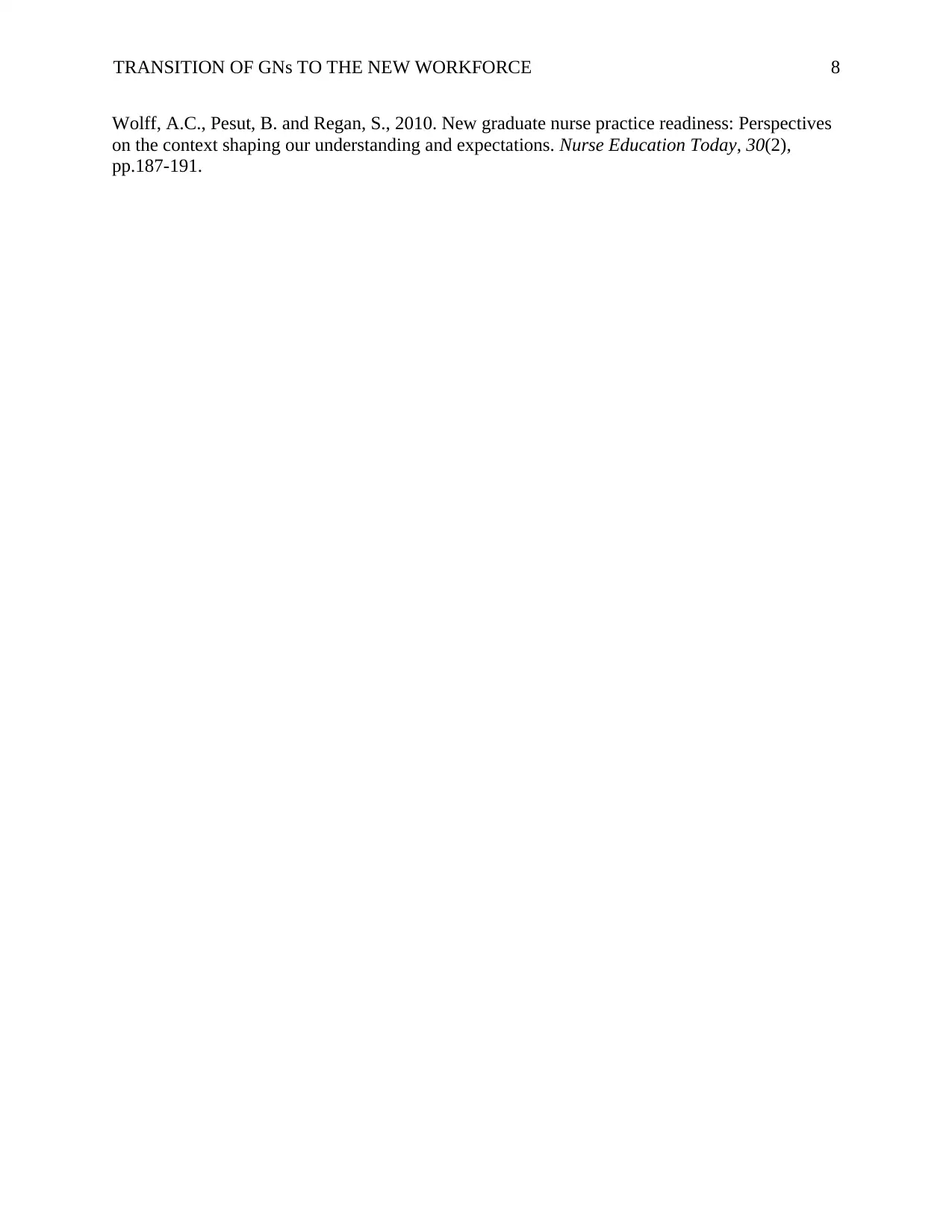
TRANSITION OF GNs TO THE NEW WORKFORCE 8
Wolff, A.C., Pesut, B. and Regan, S., 2010. New graduate nurse practice readiness: Perspectives
on the context shaping our understanding and expectations. Nurse Education Today, 30(2),
pp.187-191.
Wolff, A.C., Pesut, B. and Regan, S., 2010. New graduate nurse practice readiness: Perspectives
on the context shaping our understanding and expectations. Nurse Education Today, 30(2),
pp.187-191.
1 out of 8
Related Documents
Your All-in-One AI-Powered Toolkit for Academic Success.
+13062052269
info@desklib.com
Available 24*7 on WhatsApp / Email
![[object Object]](/_next/static/media/star-bottom.7253800d.svg)
Unlock your academic potential
Copyright © 2020–2025 A2Z Services. All Rights Reserved. Developed and managed by ZUCOL.





